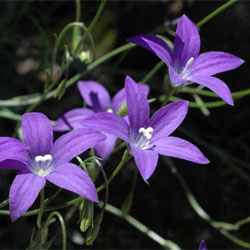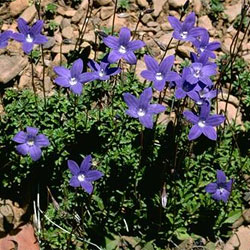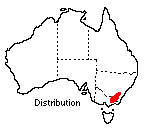Wahlenbergia gloriosa
 |
 |
Royal Bluebell
Wahlenbergia gloriosa, commonly known as the Royal Bluebell, belongs to the bluebell family Campanulaceae. It is naturally restricted to the alpine and sub-alpine areas of the Australian Capital Territory (ACT), south-eastern New South Wales and eastern Victoria. It often grows in rocky sites and also in alpine herbfields and grasslands.
 A
committee was formed in November 1981 to recommend a suitable floral emblem
for the ACT. This committee unanimously recommended the Royal Bluebell as the
floral emblem on the 26th of May, 1982.
A
committee was formed in November 1981 to recommend a suitable floral emblem
for the ACT. This committee unanimously recommended the Royal Bluebell as the
floral emblem on the 26th of May, 1982.
W. gloriosa is a small, slender, creeping to semi-erect perennial herb. It has spreading rhizomes with several to many simple and erect stems. The small dark-green leaves are usually opposite with oblong wavy edges that broaden toward the apex. The deep blue to purple bell-shaped flowers are erect on long slender stems with a few distant narrow bracts. Flowers are about 3 cm in diameter and there are usually 5 petals. The petals of the flower are edible and they make a delightful addition to a mixed salad of greens. The fruit is a small capsule of obconic shape.
Three methods; division, cuttings and seed can be used to carry out propagation. Division is where small 'plugs'of the plant are taken and either transplanted to other parts of the garden or into pots for growing on. This method can be used at almost any time of the year preferably in spring and autumn, except at the height of summer. Cuttings are where small lengths of roots or stems are removed from the plant and set as for normal cuttings. This can be done at any time of the year but preferably in late spring. Seed collected from November until May can be sown in a punnet containing fine sand and kept moist until germination takes place. The seedlings are then pricked out into pots and grown on until ready for planting.
W. gloriosa is a frost hardy ground cover and grows best in a light, enriched soil in either sunny or semi-shaded positions in cool regions. As the plant is very shallow rooted, the soil should be kept moist but not water logged and well-drained soils are essential. During drier spells, watering should be increased. The soil can be enriched by the use of well-rotted compost or other organic matter, such as humus. The organic material added to the soil also helps to lighten it, thus enabling the plant to sucker and spread, sometimes over large distances. Even though it suckers, it does not have the potential to become a problem in the garden. Feeding with a soluble liquid fertiliser during the growing seasons of spring and autumn can produce more vigorous growth, especially in established plants. Though it makes great ground cover it also grows very well in shallow pots and hanging baskets.
The flowering period usually extends from October through to March. The flowers are short-lived when cut but potted specimens in flower are suitable for indoor decoration in brightly lit positions.
Text by Joe Halloran (2002 Student Botanical Intern)
Name meaning: Wahlenbergia gloriosaWahlenbergia - The genus Wahlenbergia was proposed by the German botanist Heinrich A Schrader in 1814 in honour of Georg Goran Wahlenberg (1780-1851), a Professer of Botany at Uppsula, Sweden, and described by Albercht Roth in 1821. gloriosa - is Latin for superb or glorious, a reference to superb qualities of a plant worthy of cultivation. |
References:
Fraser, I.and McJannett, M. (1998). Wildflowers of the Snow Country: A Field Guide to the Australian Alps.
Greig, D. (1990). Colour Guide to the Wildflowers of Eastern Australia.
Harris, T.Y. (1970). Alpine Plants of Australia.
Morley, B.D. and Toelken, H.R. (eds). (1983). Flowering Plants in Australia.
Gwen J. Harden (ed.). (1993). Flora of New South Wales. Volume 4.
Australian National Botanic Gardens: Australian Floral Emblems http://www.anbg.gov.au/emblems/act.emblem.html
![An Australian Government Initiative [logo]](/images/austgovt_brown_90px.gif)

